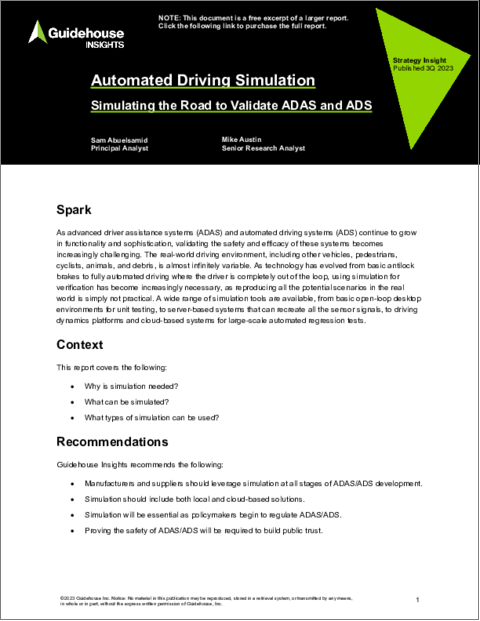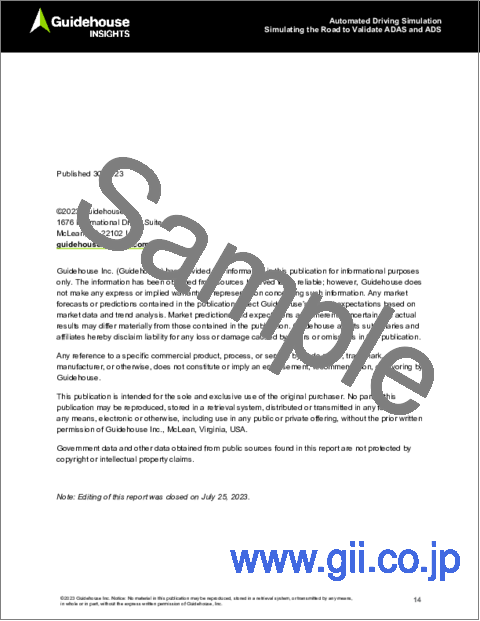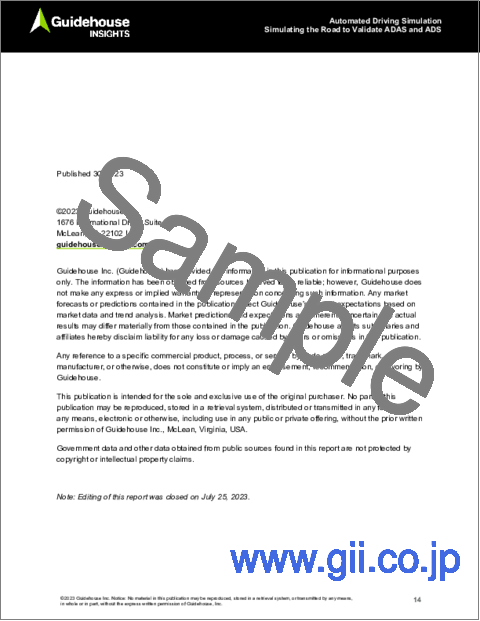|
|
市場調査レポート
商品コード
1328595
自動運転シミュレーション:ADASとADSを検証するための道路シミュレーションAutomated Driving Simulation: Simulating the Road to Validate ADAS and ADS |
||||||
|
|||||||
| 自動運転シミュレーション:ADASとADSを検証するための道路シミュレーション |
|
出版日: 2023年07月26日
発行: Guidehouse Research
ページ情報: 英文 14 Pages; 4 Tables, Charts & Figures
納期: 即納可能
|
- 全表示
- 概要
- 図表
- 目次
自動車メーカーやサプライヤーは年々、ADAS (先進運転支援システム) やADS (自動運転システム) が人間のドライバーを補完したり、代替したりできる範囲を拡大し続けています。その主な目標のひとつは、衝突事故を減らすことで交通安全を向上させることです。しかし、運転は人間が非常に高い頻度で行う非常に複雑な作業です。米国だけでも、人々は年間3兆2,000億マイルもの距離を運転していますが、事故は平均して50万マイルに1回程度しか起きていません。
ADASとADSが人間のドライバーよりも実際に安全であることを検証することは、特に運転環境のほぼ無限の変動性とテスト条件の再現の難しさを考えると、非常に高いハードルです。シミュレーションは、過去数十年にわたって自動車の安全システムを検証するための極めて重要なツールとなっており、ADAS/ADSの有効性を証明するためにも不可欠です。
ADAS/ADSの開発者は、新しいコンセプトを検証し、すでに機能することが実証されているシステムに変更があってもエラーが発生しないことを確認するために、開発・試験プロセスのあらゆる段階でさまざまなシミュレーションツールを利用しています。ソフトウェア・ハードウェア・ドライバーをループに組み込んだオープン/クローズド・ループシミュレーションは、いずれも広く使用されています。テストスイートの十分なカバレッジを確保するためには、テストシナリオを生成する自動化ツールも必要です。ほとんどのシミュレーションのワークフローは、複数のベンダーのさまざまなツールを組み合わせており、ADASとADSが公道に導入される前に安全性の向上に貢献することを保証するのに役立っています。
目次
- 序論
- 背景事情
- 推奨事項
- ADAS・ADSの出現による、シミュレーション需要の増大
- 物理的な運転環境の仮想空間での再現
- コンピューティングプラットフォーム
- シミュレーションの種類
- ユニット・サブシステムシミュレーション
- フルスタックシミュレーション
- ソフトウェア・イン・ザ・ループ
- ハードウェア・イン・ザ・ループ
- ドライバー・イン・ザ・ループ
- モデルとシナリオ
- 車両の物理的モデリング
- センサーモデリング
- シーンモデリング
- シナリオ構築
- モデルの検証
- 安全な自動化に必要な仮想検証
- インフラデータの収集と共有
- 規制に向けて
List of Figures
- Annual Light Duty Vehicle Deployments by Automation Level, World Markets: 2022-2031
NVIDIA DRIVE Sim's Virtual Driving Environments and Simulated Sensor Inputs
VI-grade's DiM150 Dynamic Driving Simulator at Ford Product Development Center
Vehicle Physics Simulation Model
With each passing year, automakers and suppliers are continuing to expand the scope of what advanced driver assistance systems (ADAS) and automated driving systems (ADS) can do to supplement or replace human drivers. One of the primary goals is to improve road safety by reducing the number of crashes. However, driving is a very complex task that humans do with a very high frequency. In the US alone, people drive as much as 3.2 trillion miles per year and only crash about once every half million miles on average.
Validating that ADAS and ADS are actually safer than human drivers is a very high bar, particularly given the nearly infinite variability of the driving environment and the difficulty of reproducing test conditions. Simulation has become a crucial tool for validating automotive safety systems over the past several decades, and it is essential for proving the efficacy of ADAS/ADS.
ADAS/ADS developers rely on a range of simulation tools at all stages of the development and testing process to validate new concepts and ensure that changes have not caused errors in systems that are already demonstrated to work. Open- and closed-loop simulations with software, hardware, and drivers in the loop are all being used extensively. Automated tools to generate testing scenarios are also needed to ensure sufficient coverage of the test suite. Most simulation workflows combine a range of tools from multiple vendors to help guarantee that ADAS and ADS contribute to improved safety before the technology is deployed on public roads.
Table of Contents
Spark
Context
Recommendations
The Emergence of ADAS and ADS Drives Simulation Demand
Replicating the Physical Driving Environment in Virtual Space
Compute Platforms
Simulation Types
Unit and Subsystem Simulation
Full-Stack Simulation
Software in the Loop
Hardware in the Loop
Driver in the Loop
Models and Scenarios
Vehicle Physics Modeling
Sensor Modeling
Scene Modeling
Scenario Building
Model Validation
Safe Automation Needs Virtual Validation
Collecting and Sharing Infrastructure Data
Looking toward Regulations






